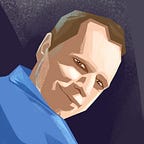Editing 3D 360 Vuze
We’ve spent the last month, on and off, filming and editing Vuze Camera footage. We’ve been filming at our studio in Leeds, and on location in Yorkshire and the surrounding region, both indoors and out. It’s taught is quite a few things about the process.
Stitching Video Together
Eight cameras record eight videos. The Vuse outputs that two videos in a single file (some software will only see one of those videos). Each of those videos contains the four videos which make up a single 360 video for one eye, but not yet stitched or warped correctly for playback. You need to edit the videos together, which involves shifting the videos slightly to get a perfect stitch.
We’ve tried loads of different stitching software and techniques, including various amounts of manual work. Our best results so far have been from automatically stitching use Vuse VR Studio though (also known as Human Eyes VR Studio). This is the software that Vuse give you. While it’s not perfect, you can trust me when I say it’s still very impressive.
To get the best results, there are a couple of things you need to do which aren’t default. We’ve found there are a couple of points during this process which cause the software to crash on some machines. Powerful computers tend to be fine, so I’d guess that was a consideration in setting these defaults.
There’s no money saved by not having powerful editing hardware.
Once you’ve imported your video, you need to scrub about half way through your video. Pick a frame with nothing too close to the camera, then add that frame to refine the stitching — Preview & Edit > Settings > Refine Stitching > Add Current Frame. It takes a few seconds to run, then you’ll immediately see the stitching has improved. If you’re on a static tripod, that’s the only frame you’ll need to add.
Set blending level to high — Preview & Edit > Settings > Blending Level > High. Color (Ed: colour!) correction should be set to Advanced too, but you should find that’s the default.
Removing the Equipment
If you have a tripod in the scene at this point (I may put a post together in the future about removing it before stitching, but that requires a bit more forward planning), then this is the next thing you should tackle.
We do this by making two masks — one for each eye. The tripod always fills the same section of video, and usable video never includes anything passing under the camera, so you can make static images in Photoshop.
Working to a new layer, paint over the parts of the tripod you can see until you’re happy with the result. Here’s the tricky part though — you cannot create anything which doesn’t work in Stereoscopic 3D! Everything that you add to one eye, must have an equivalent for the other.
If you begin with a content aware fill for each eye, you’ll create textures which appear different in each video. The result will be the user seeing different images with different eyes when they look down. It’s untidy, and tends to jump our of the video.
For the ease of explanation, we’ll start by painting the left eye. You can obviously tackle this either way.
Start by using the information you have. Use parts of the floor you can see on right eye, to remove tripod on the left. Stritch and move your copied right floor so it lines up with the left. It’s important you line up using the scene, not the frame of the video. Then paint over what remains.
Now copy your completed left eye mask, over the right eye. Line up with the floor again, and paint over the last items. Refer to the left eye whenever you’re painting new texture — remember, you have a complete floor there. If the floor is reasonable flat, that should be all the information you need.
Anything you invent, will likely not work in Stereo 3D. If you’ve had to invent a lot, you may need to blur your indiscretions.
Render
You can lay your masks over in your video editing software of choice. We used Premiere. Your process may mean you’re already in After Effects, because you just like to be when you’re using Photoshop for video work.
We also did some foley work at this point, because the mic on the Vuze picks up a lot of wind and background noise. It was easier for us to use the recorded audio as reference, but you should set up several mics if you want to record decent directional audio (possibly another future post).
This article was made possible by Dubit.
